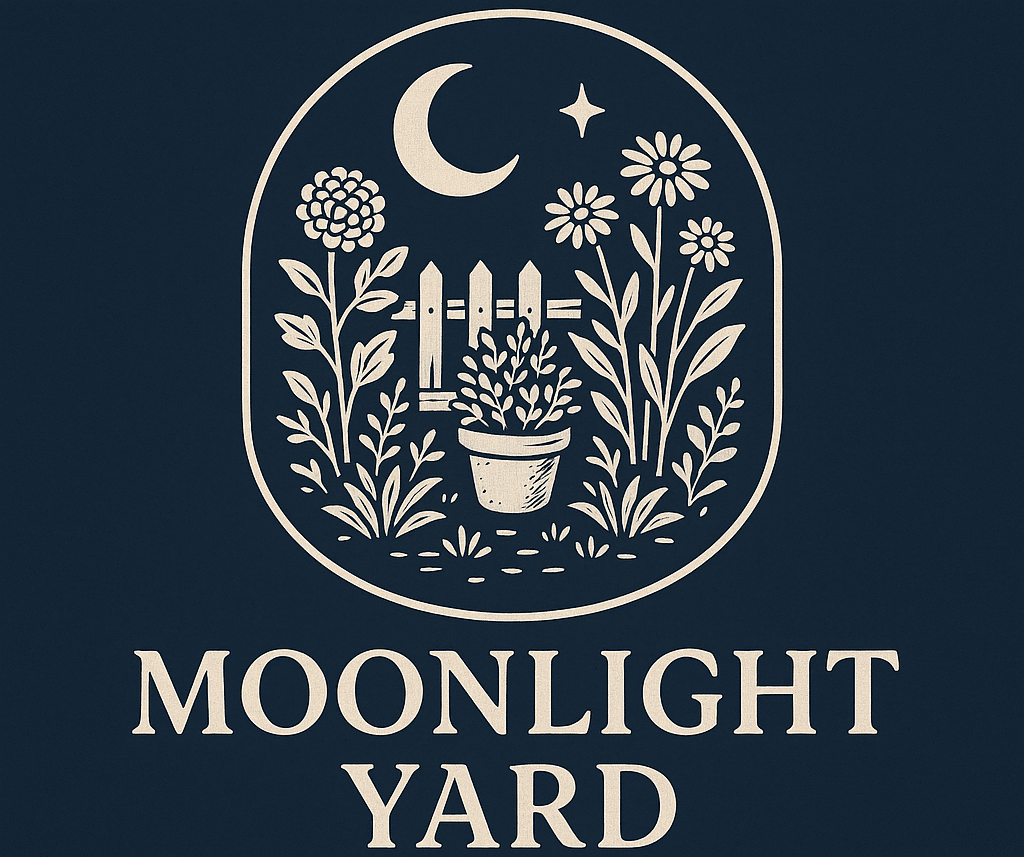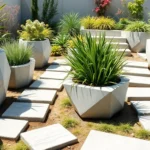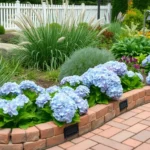When we think of stunning garden focal points, blue flowering trees instantly capture our imagination with their rare and mesmerizing blooms. These exceptional specimens bring an ethereal quality to landscapes that’s simply unmatched by more common flowering varieties.
Blue blossoms create a sense of tranquility and wonder that transforms any outdoor space into a botanical masterpiece. We’ve discovered that homeowners and garden enthusiasts consistently rank blue flowering trees among their most coveted industry additions – and for good reason.
From the iconic Jacaranda with its trumpet-shaped clusters to the delicate Blue Palo Verde that paints desert landscapes, these trees offer something truly special. We’ll explore the most spectacular blue flowering varieties that’ll elevate your garden design and provide year-round visual interest. Whether you’re planning a complete industry renovation or simply want to add that perfect statement piece, blue flowering trees deliver the dramatic impact you’re seeking.
Jacaranda Trees: The Most Famous Blue Flowering Specimens
We can’t discuss blue flowering trees without highlighting the magnificent Jacaranda, which stands as the most recognizable specimen in this category. These trees create breathtaking displays that transform entire neighborhoods into purple-blue wonderlands.
Purple-Blue Trumpet-Shaped Blooms
Jacaranda trees produce clusters of tubular flowers that cascade in drooping panicles measuring 8-12 inches long. Each individual bloom measures about 2 inches in length and displays a vibrant purple-blue hue that ranges from deep lavender to brilliant violet. The trumpet-shaped flowers create dense clusters that cover the entire canopy, typically blooming from late spring through early summer.
We observe peak flowering periods lasting 6-8 weeks, during which trees become completely covered in blooms. The flowers fall gracefully to create natural carpets beneath the tree, maintaining their color for several days after dropping. This characteristic makes Jacarandas popular choices for parks, streets, and residential landscapes where dramatic seasonal displays are desired.
Ideal Growing Conditions and Climate Requirements
Jacaranda trees thrive in USDA hardiness zones 9-11, requiring warm climates with minimal frost exposure. We recommend planting these specimens in areas with full sun exposure and well-draining soil for optimal flowering performance. The trees prefer slightly acidic to neutral soil pH levels between 6.0-7.0.
Temperature requirements include consistent warmth above 60°F, with ideal growing conditions between 75-85°F during active growing seasons. These trees need distinct wet and dry seasons to trigger proper bloom cycles, making them perfect for Mediterranean and subtropical climates. We’ve found that young trees require regular watering during establishment, while mature specimens develop drought tolerance.
Popular Varieties and Cultivars
Jacaranda mimosifolia remains the most widely planted species, reaching heights of 25-50 feet with equal spread dimensions. We encounter several notable cultivars that offer unique characteristics for different industry applications:
Jacaranda mimosifolia ‘Bonsai Blue’ stays compact at 6-8 feet tall, making it suitable for smaller gardens and container growing. Jacaranda cuspidifolia produces deeper purple blooms and grows more densely than standard varieties. Jacaranda mimosifolia ‘Alba’ offers rare white flowers for gardeners seeking alternative color options.
We also recommend Jacaranda chelonia for coastal areas, as this species tolerates salt spray better than other varieties. Each cultivar maintains the signature fern-like foliage and spectacular flowering display that makes Jacarandas the premier choice among blue flowering trees.
Blue Chaste Tree: Fragrant Spikes of Lavender-Blue Flowers
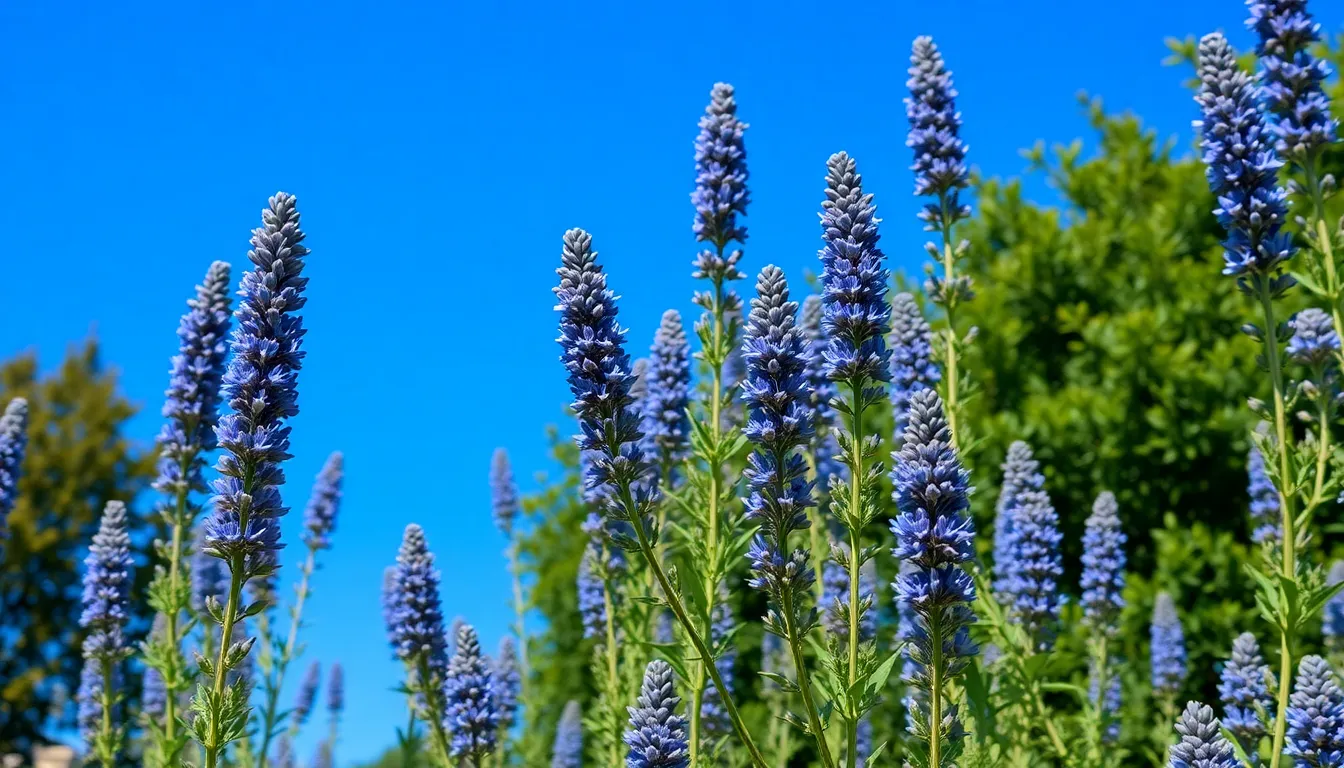
Blue Chaste Trees offer gardeners an exceptional combination of stunning lavender-blue blooms and practical growing benefits. These distinctive trees create vertical spikes of fragrant flowers that complement the horizontal canopy displays we’ve seen with Jacarandas.
Aromatic Foliage and Medicinal Properties
Aromatic qualities make the Blue Chaste Tree stand out among blue flowering varieties, with leaves that release a pleasant fragrance when brushed or crushed. Essential oils within the foliage have been traditionally valued for their medicinal properties, particularly in herbal remedies and natural wellness applications. Gardeners appreciate how the scented leaves provide year-round sensory appeal, even when the tree isn’t blooming.
Traditional uses of the Blue Chaste Tree include supporting hormonal balance and women’s health, earning it recognition in folk medicine practices across different cultures. Modern herbalists continue to value the tree’s therapeutic compounds, though we recommend consulting healthcare professionals before using any plant medicinally. The aromatic foliage also acts as a natural pest deterrent, helping protect surrounding plants in your garden industry.
Drought Tolerance and Low Maintenance Care
Drought tolerance ranks as one of the Blue Chaste Tree’s most appealing characteristics for busy homeowners seeking beautiful blue blooms without intensive care requirements. Established trees can survive extended dry periods, making them ideal choices for water-wise gardens and xeriscaping projects. Minimal watering needs mean you’ll spend less time maintaining these trees compared to other flowering varieties.
Low maintenance care requirements include basic pruning to maintain shape and occasional fertilizing during the growing season. These trees adapt well to various soil types, though they perform best in well-draining conditions similar to other blue flowering specimens. Pest and disease issues rarely affect Blue Chaste Trees, reducing the need for chemical treatments and ongoing monitoring.
Seasonal Blooming Patterns
Seasonal blooming occurs primarily during late summer and early fall, providing blue color when many other flowering trees have finished their displays. Fragrant spikes emerge in dense clusters, creating vertical columns of lavender-blue flowers that attract butterflies and beneficial pollinators to your garden space. Extended blooming periods can last several weeks, offering prolonged enjoyment of the tree’s spectacular floral show.
Peak flowering typically coincides with the transition from summer to autumn, making Blue Chaste Trees valuable for extending seasonal interest in your industry design. Multiple flower spikes develop throughout the canopy, creating a full, abundant appearance that rivals the density of spring-blooming varieties. Climate variations can influence exact timing, with warmer regions often experiencing longer blooming windows than cooler areas.
Empress Tree: Fast-Growing Blue-Purple Flowering Giant
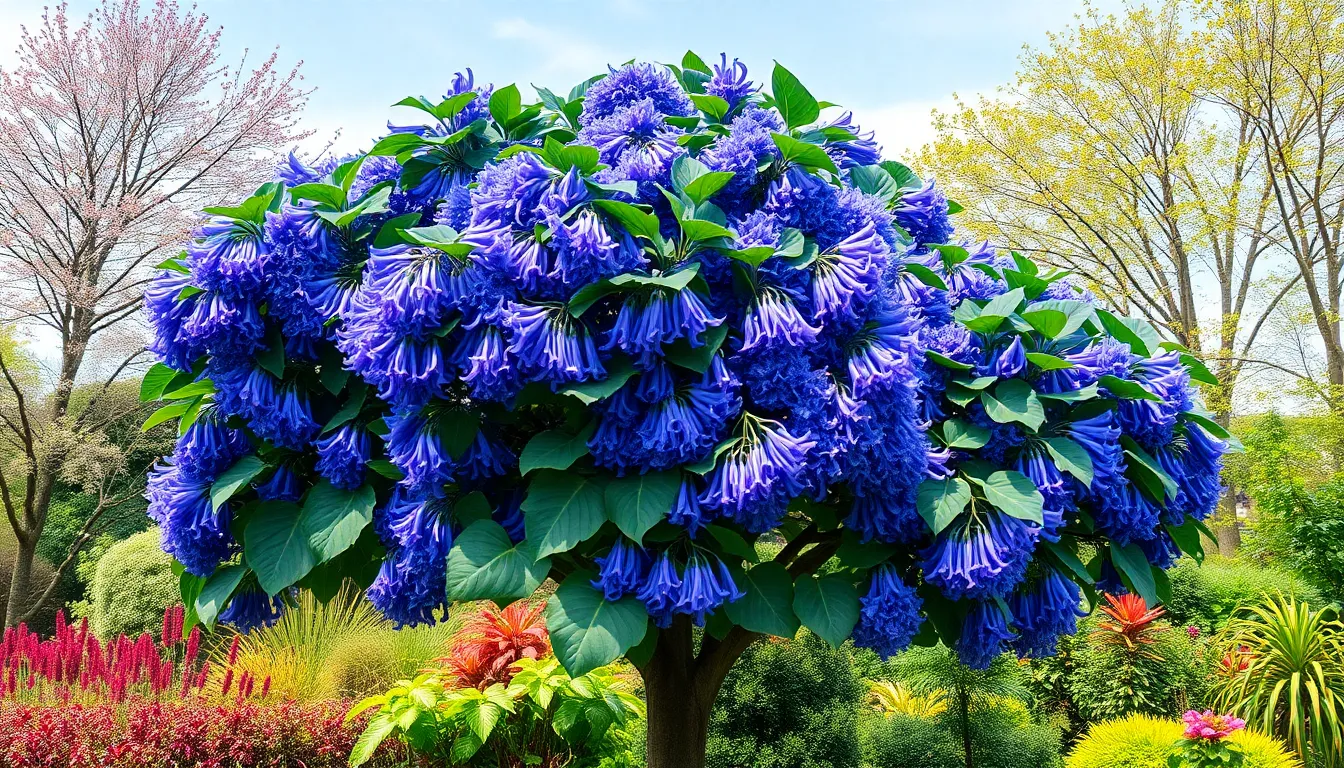
While Jacarandas and Blue Chaste Trees offer stunning displays, the Empress Tree presents a different category of blue flowering magnificence with its remarkable size and growth speed.
Rapid Growth Rate and Large Heart-Shaped Leaves
Empress Trees achieve extraordinary growth rates that surpass most flowering trees in our gardens. We’ve observed specimens reaching 10-15 feet in their first year under optimal conditions. Fast-growing characteristics make this tree ideal for homeowners seeking quick industry transformation and immediate visual impact.
Large heart-shaped leaves distinguish the Empress Tree from other blue flowering varieties we’ve discussed. These impressive leaves can grow 6-12 inches wide, creating dense canopies that provide substantial shade coverage. The foliage emerges early in spring and maintains its lush appearance throughout the growing season.
Fragrant Tubular Flowers in Spring
Fragrant tubular flowers appear in spectacular clusters before the leaves emerge each spring. We notice these blooms range from pale lavender to deep purple-blue, creating breathtaking displays that rival traditional blue flowering trees. The trumpet-shaped blossoms measure 2-3 inches long and emit a sweet, honey-like fragrance that attracts hummingbirds and butterflies.
Spring flowering occurs typically in April and May, depending on your climate zone. Each flower cluster can contain dozens of individual blooms, transforming bare winter branches into stunning floral showcases that complement Jacaranda displays in warmer regions.
Invasive Species Considerations
Invasive species concerns require careful consideration before planting Empress Trees in our landscapes. The tree can outcompete native vegetation through aggressive root systems and prolific seed production. We’ve documented cases where Empress Trees establish unwanted colonies in natural areas, displacing indigenous plant communities.
Responsible planting practices include selecting sterile cultivars when available and regular monitoring for unwanted seedlings. Many states restrict or prohibit Empress Tree planting due to ecological impacts, so we recommend checking local regulations before incorporating this blue flowering giant into your garden design.
Texas Mountain Laurel: Grape Soda Scented Blue Blooms

Unlike other blue flowering trees that provide purely visual impact, the Texas Mountain Laurel brings an unforgettable multisensory experience to your industry. We’ve discovered that this remarkable tree combines stunning blue purple flowers with a sweet fragrance that transforms gardens into aromatic retreats.
Distinctive Fragrance and Silvery Foliage
Texas Mountain Laurel produces vibrant blue purple flowers arranged in pendulous clusters measuring 5-15 cm long that emit a distinctive sweet fragrance reminiscent of grape soda or grape Kool Aid. These spectacular blooms appear from February to April, creating an early spring display that captivates homeowners with both visual beauty and intoxicating scent. The evergreen foliage consists of glossy, leathery pinnately compound leaves featuring 7-9 leaflets that provide year round interest. We appreciate how the silvery green foliage creates an elegant backdrop for the intensely colored flower clusters, making this tree a standout choice among blue flowering varieties.
Native Texas Habitat and Adaptation
Native to southern and central Texas, this resilient tree thrives in diverse soil conditions including limestone, sand, loam, and clay as long as drainage remains adequate. We’ve found that its extreme drought tolerance makes it exceptionally suitable for arid landscapes where other blue flowering trees might struggle. Established Texas Mountain Laurels can survive with minimal annual rainfall, requiring virtually no supplemental watering once their root systems develop. This remarkable adaptation to harsh conditions sets it apart from moisture loving blue flowering trees like Jacarandas, making it perfect for water conscious gardening approaches.
Seed Pod Characteristics
Following the spectacular spring blooming period, Texas Mountain Laurel produces fuzzy tan to gray seed pods containing shiny red, orange, or burgundy seeds that add decorative interest to the tree. These hard pods are difficult to break open naturally but must be carefully managed since the colorful seeds are highly toxic to humans and pets. We strongly recommend keeping these attractive but dangerous seeds away from children and animals who might be tempted by their bright appearance. The seed pods provide extended seasonal interest while requiring responsible handling to ensure garden safety for families with curious pets or young children.
Blue Hibiscus: Tropical Blue Flowering Beauty
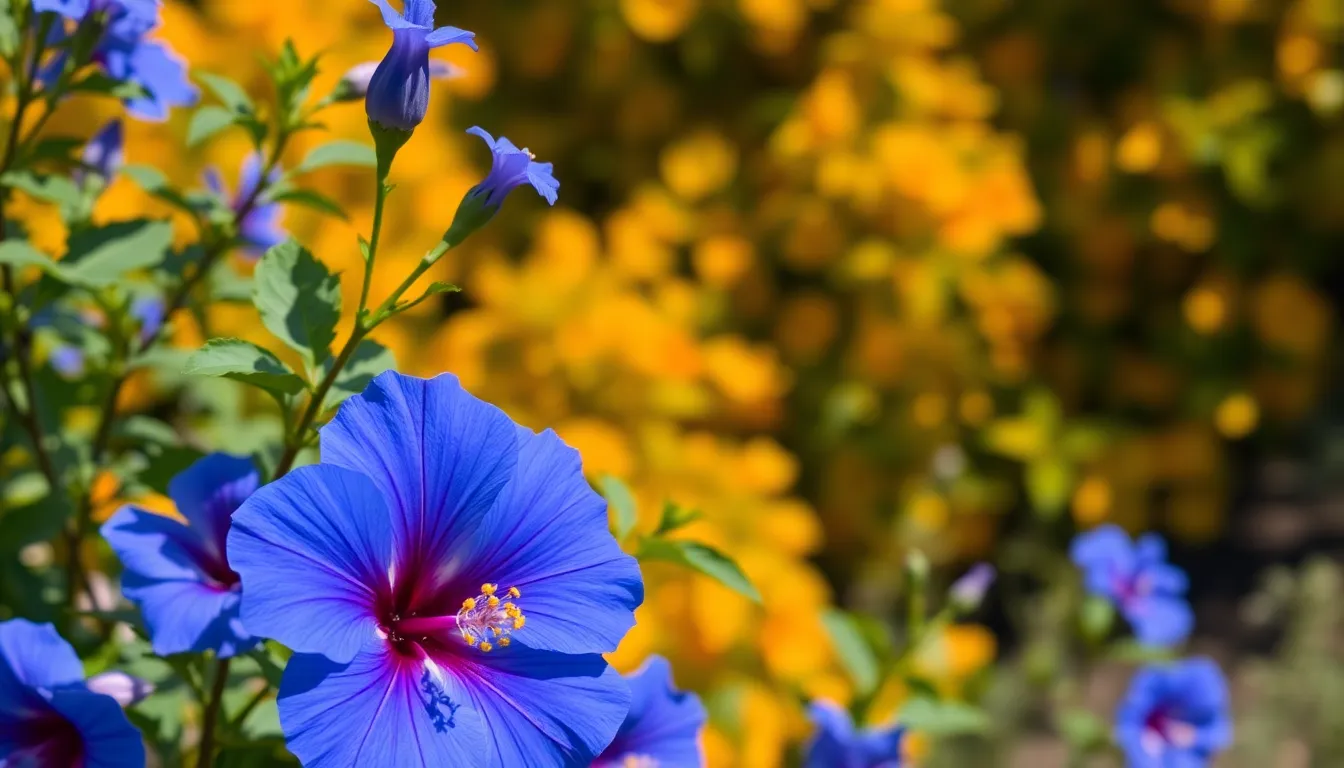
While technically a shrub rather than a traditional tree, the Blue Hibiscus brings tropical elegance to our gardens with its vibrant blue flowers. We’ve found this stunning plant offers unique advantages that complement the larger blue flowering trees we’ve discussed.
Continuous Blooming Throughout Growing Season
Blue Hibiscus delivers what many other blue flowering plants cannot: continuous blooms from spring through fall. Unlike the seasonal displays of Jacarandas or Texas Mountain Laurels, this tropical beauty produces new flowers daily throughout the growing season. Each bloom lasts only one to two days, but the plant immediately replaces spent flowers with fresh ones.
We recommend deadheading spent blooms to encourage even more prolific flowering. Peak blooming occurs during warm summer months when temperatures consistently reach 70-85°F. Regular fertilization every 4-6 weeks with a balanced fertilizer maintains this impressive blooming schedule.
Container Growing and Indoor Care
Container cultivation makes Blue Hibiscus accessible to gardeners in colder climates where outdoor planting isn’t feasible. We suggest using pots at least 12-14 inches in diameter with drainage holes to accommodate the root system. Terra cotta or ceramic containers work best because they allow proper air circulation around the roots.
Indoor growing requires bright, direct sunlight for at least 6 hours daily, preferably from a south facing window. Supplemental grow lights become necessary during winter months in northern regions. Humidity levels should remain between 40-60% for optimal growth, which we can achieve using humidity trays or room humidifiers.
Temperature control proves critical for indoor Blue Hibiscus care. Maintain daytime temperatures between 65-75°F and nighttime temperatures no lower than 60°F. Cold drafts from windows or air conditioning vents can cause bud drop and stress the plant.
Pruning and Maintenance Requirements
Regular pruning keeps Blue Hibiscus healthy and promotes bushier growth with more flowering sites. We prune in early spring before new growth begins, removing dead, damaged, or crossing branches first. Light pruning throughout the growing season encourages continuous blooming and maintains the desired shape.
Pinching growing tips when the plant reaches 6-8 inches tall creates a fuller, more compact form. This technique forces the plant to develop multiple stems instead of growing tall and leggy. Sharp, clean pruning shears prevent disease transmission between cuts.
Well drained soil remains essential for Blue Hibiscus health, whether grown in containers or garden beds. We mix standard potting soil with perlite or coarse sand to improve drainage. Overwatering causes root rot, while underwatering leads to wilting and flower drop. Check soil moisture by inserting your finger 1-2 inches deep into the soil before watering.
Plumbago Tree: Delicate Sky-Blue Clustered Flowers
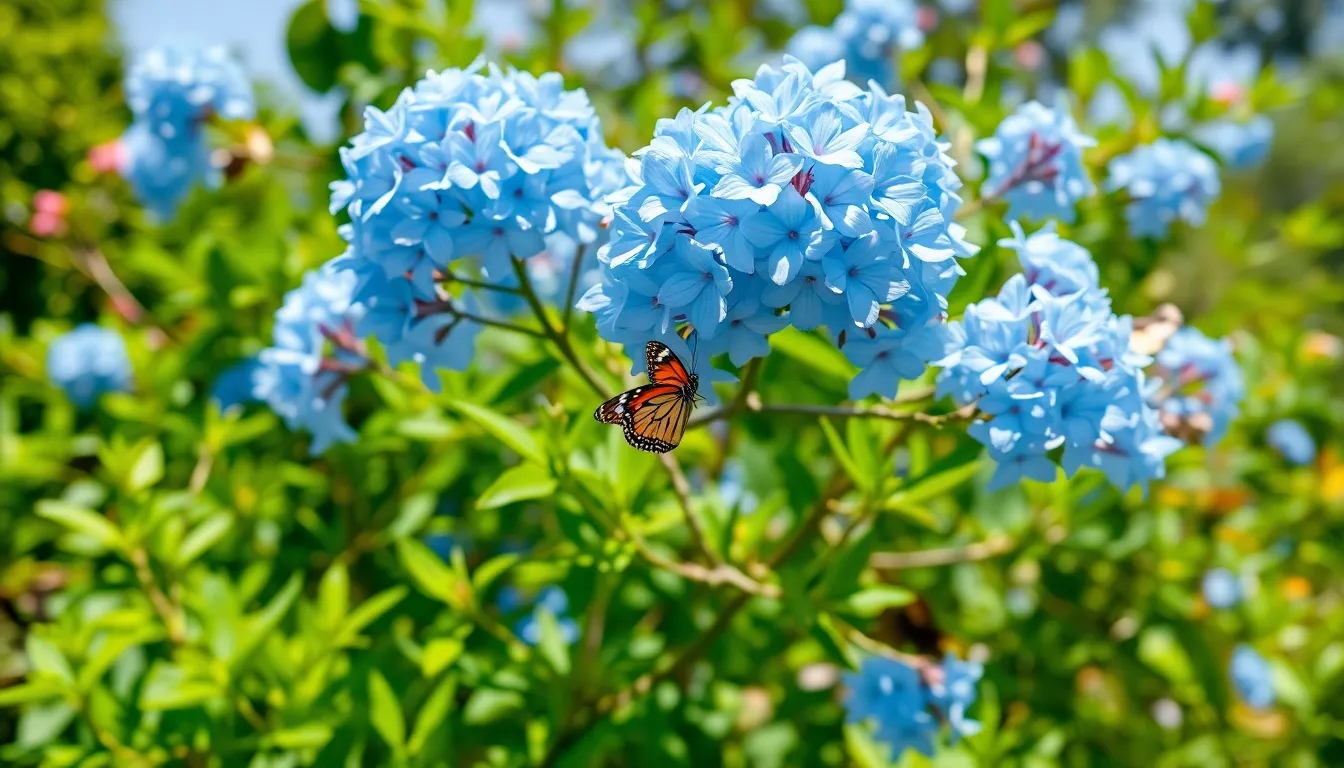
Plumbago trees bring a refreshing contrast to the bold displays we’ve explored with their delicate sky-blue clustered flowers. These charming flowering trees offer gardeners a gentler approach to incorporating blue blooms into their industry design.
Heat Tolerance and Versatile Growing Conditions
Plumbago trees excel in challenging conditions where other blue flowering varieties might struggle. Heat tolerance makes them particularly valuable for southern gardens and areas with intense summer temperatures. Unlike moisture-dependent blue flowering trees, plumbago adapts to drought conditions once established.
Versatile growing conditions allow these trees to thrive in various soil types and light exposures. Full sun locations produce the most abundant flowering displays, but partial shade areas still support healthy growth. Well-draining soil prevents root rot issues, though plumbago tolerates clay and sandy soils better than many blue flowering alternatives.
Container growing expands planting options for gardeners in colder climates. We recommend using large pots with drainage holes and moving containers indoors when temperatures drop below 35°F. Indoor overwintering requires bright, indirect light and reduced watering schedules.
Butterfly and Pollinator Attraction
Butterfly attraction sets plumbago apart from larger blue flowering trees we’ve discussed. Small clustered flowers provide perfect landing platforms for butterflies, bees, and beneficial insects. Continuous blooming from spring through fall ensures consistent nectar sources throughout growing seasons.
Pollinator gardens benefit significantly from plumbago’s extended flowering period. Native butterfly species like painted ladies and skippers frequently visit these sky-blue blooms. Hummingbirds occasionally feed from plumbago flowers, though they prefer the larger trumpet-shaped blooms of jacarandas and empress trees.
Biodiversity enhancement occurs naturally when we plant plumbago alongside other pollinator-friendly species. Creating pollinator corridors helps support local ecosystems while maintaining stunning blue flowering displays in our gardens.
Companion Planting Ideas
Heat-tolerant companions work exceptionally well with plumbago’s growing requirements. Succulents like agave, aloe, and various sedum varieties create striking textural contrasts against delicate blue clusters. Ornamental grasses such as fountain grass and Mexican feather grass add movement and height variation.
Flowering shrubs enhance color combinations throughout different seasons. Lantana provides orange and yellow blooms that complement blue flowers beautifully. Rosemary offers evergreen structure while contributing aromatic foliage and small blue flowers that echo plumbago’s coloring.
Drought-tolerant gardens benefit from pairing plumbago with lavender, salvia, and Mexican mint marigold. These combinations reduce water requirements while creating diverse textures and extended blooming periods. Ground covers like trailing rosemary or creeping thyme fill spaces between larger plantings while maintaining the drought-resistant theme.
Blue Trumpet Tree: Stunning Azure Bell-Shaped Blooms
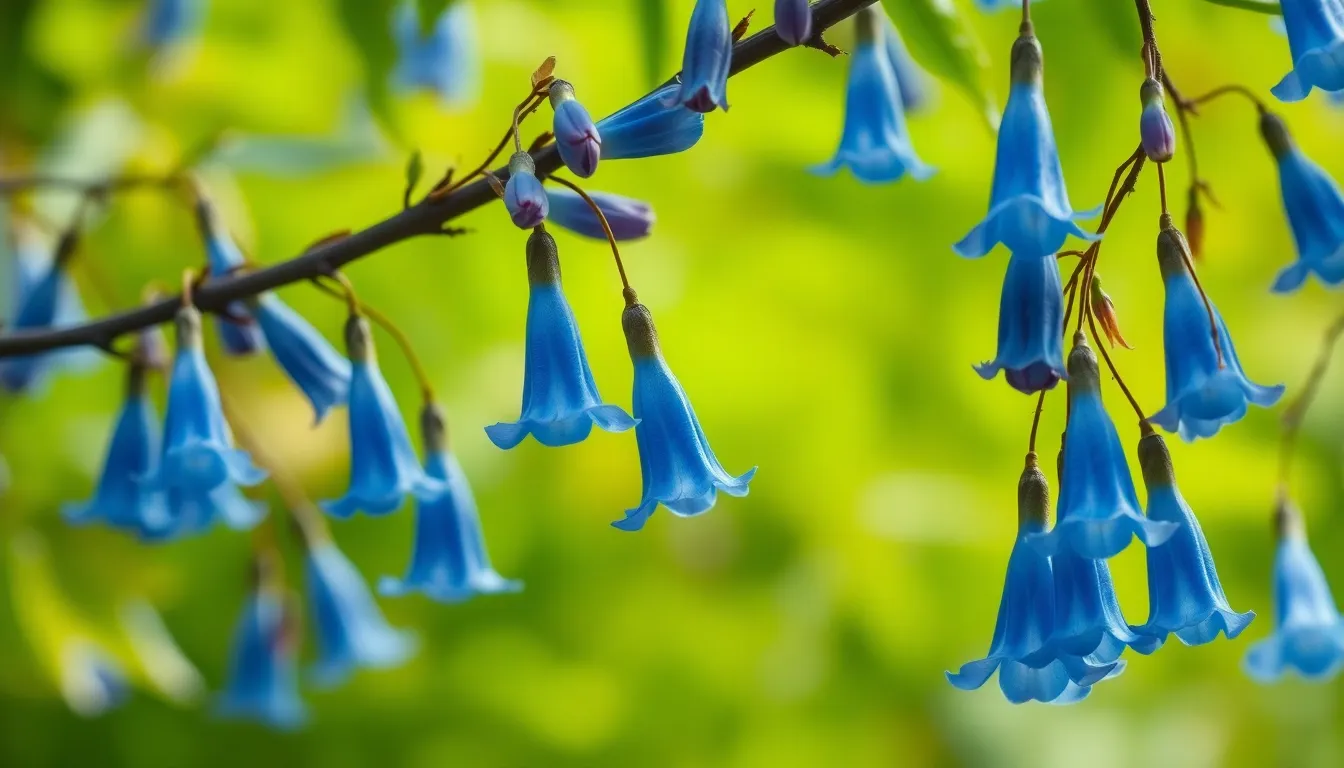
We discover exceptional beauty in blue trumpet trees, which captivate gardeners with their distinctive bell-shaped blooms that cascade in breathtaking azure displays.
Cold Hardy Varieties for Northern Climates
Wisteria stands out as our most reliable cold hardy option for northern gardens, thriving beautifully in USDA hardiness zones 5-9. Gardeners can successfully cultivate this stunning blue flowering tree even in regions with harsh winters. Training Wisteria as a tree form requires proper support structures, but the reward comes in spectacular blue flower clusters that drape elegantly from sturdy branches.
Northern climate enthusiasts benefit from Wisteria’s remarkable cold tolerance, which extends the geographic range where we can enjoy blue trumpet shaped blooms. Established trees withstand freezing temperatures while maintaining their structural integrity throughout winter months. Spring arrives with an explosion of fragrant blue flowers that transform bare winter landscapes into enchanting garden displays.
Seasonal Color Changes and Fall Interest
Jacaranda trees provide year-round visual appeal through their soft, feathery foliage that maintains elegant texture beyond the blooming season. Spring brings the primary spectacle with lavender-blue trumpet flowers creating dense canopy coverage. Summer transitions reveal the delicate fern-like leaves that flutter gracefully in warm breezes.
Fall interest develops as the foliage shifts to subtle golden tones before dropping, revealing the tree’s sculptural branch structure. Winter silhouettes showcase the Jacaranda’s architectural beauty, with bare branches creating striking patterns against crisp sky backgrounds. Blue Buddleia cultivars like Empire Blue and Nanho Blue extend seasonal color by blooming repeatedly throughout growing seasons, attracting pollinators well into autumn months.
Propagation Methods and Techniques
Seed sowing offers the most accessible propagation method for Jacaranda trees, though germination requires warm temperatures and consistent moisture. Grafting techniques work best for maintaining exact cultivar characteristics in blue trumpet trees. Vegetative propagation through grafting ensures we preserve the exact flower color and growth habits of parent plants.
Wisteria propagates successfully through layering methods, where we bend flexible branches to ground level and cover sections with soil until roots develop. Cutting propagation works well for established Wisteria plants, using semi-hardwood cuttings taken during late summer months. Buddleia varieties root easily from softwood cuttings, making them among the simplest blue flowering trees to propagate at home.
Care Tips for Blue Flowering Trees
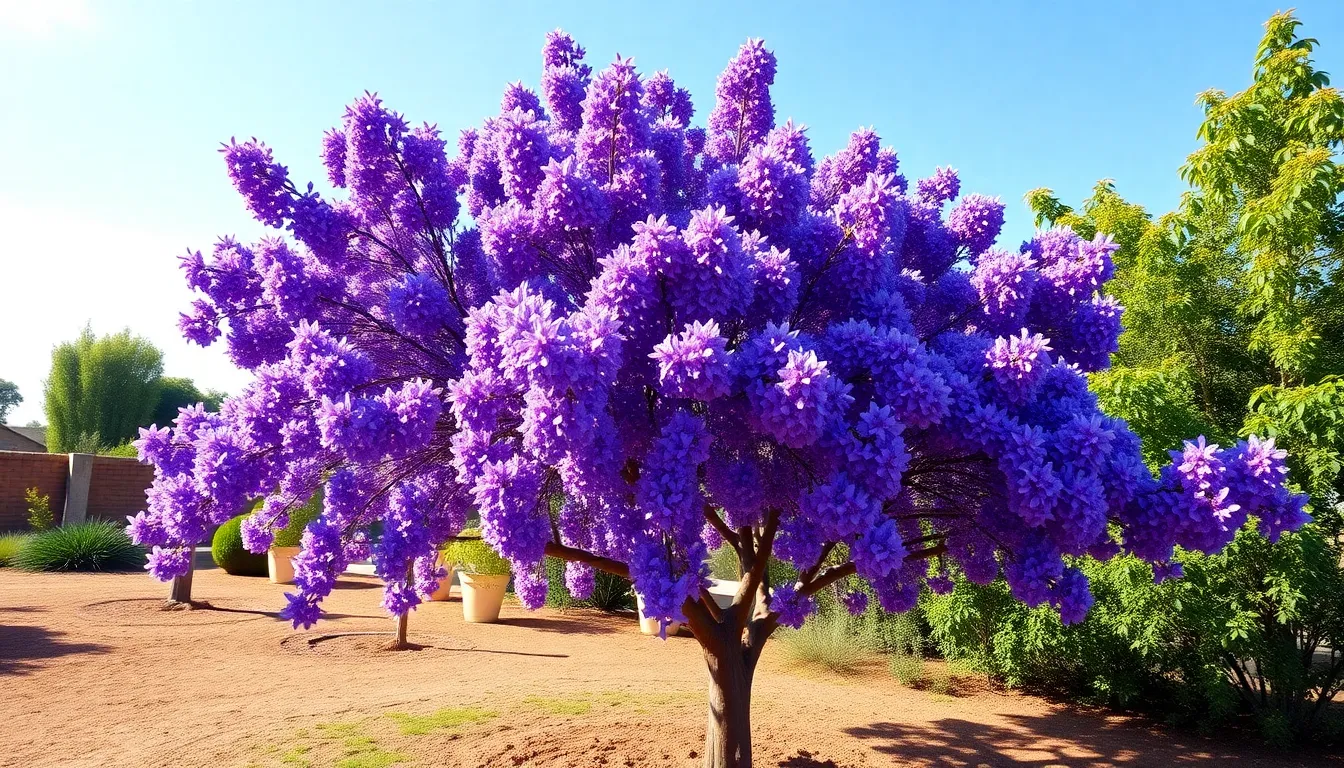
Proper care ensures your blue flowering trees thrive and produce spectacular displays year after year. Understanding their exact needs helps maximize blooming potential and maintain healthy growth.
Soil Requirements and pH Preferences
Jacaranda Mimosifolia performs best in well-drained soil with slightly acidic to neutral pH levels between 5.5 and 6.5. We recommend testing your soil before planting to ensure optimal growing conditions for these stunning purple-blue bloomers.
Ceanothus varieties adapt to a wider pH range, thriving in slightly acidic to alkaline soils with pH levels from 6 to 8. These California natives tolerate various soil conditions but require excellent drainage to prevent root problems.
Wisteria species need well-drained, fertile soil with pH levels between 6 and 7 for maximum flowering potential. Enriching heavy clay soils with organic matter improves drainage and creates ideal growing conditions for these vigorous climbers.
Texas Mountain Laurel tolerates various soil types but prefers alkaline conditions similar to its native Texas habitat. Adding limestone to acidic soils helps create the preferred pH range for this drought-tolerant beauty.
Watering Schedules and Fertilization Needs
Jacaranda trees require regular watering during establishment but avoid overwatering once mature. We apply balanced fertilizer annually in spring to support healthy growth and prolific blooming cycles.
Ceanothus plants prefer moderate watering with soil allowed to dry slightly between applications. Light spring fertilization provides sufficient nutrients without encouraging excessive growth that reduces flowering.
Wisteria vines benefit from deep watering once or twice weekly during growing season. Apply balanced fertilizer in spring and again after blooming to support vigorous growth and next year’s flower production.
Blue Chaste Trees demonstrate excellent drought tolerance once established, requiring minimal supplemental watering. Monthly watering during summer months and annual spring fertilization maintain healthy growth patterns.
Common Pests and Disease Prevention
Jacaranda species commonly attract aphids and scale insects that weaken branches and reduce flowering. Pruning damaged branches immediately prevents disease spread and maintains the tree’s natural shape and vigor.
Ceanothus varieties suffer from root rot when soil remains too moist for extended periods. Monitor plants regularly for spider mites and aphids, especially during hot, dry weather conditions.
Wisteria plants develop fungal diseases like powdery mildew in humid conditions with poor air circulation. Regular pruning increases airflow through the canopy and reduces disease pressure significantly.
Blue flowering trees generally benefit from annual pruning to maintain shape and encourage blooming. Mulching around the base retains soil moisture and suppresses weeds while providing slow-release nutrients as organic matter decomposes.
Landscaping Ideas with Blue Flowering Trees
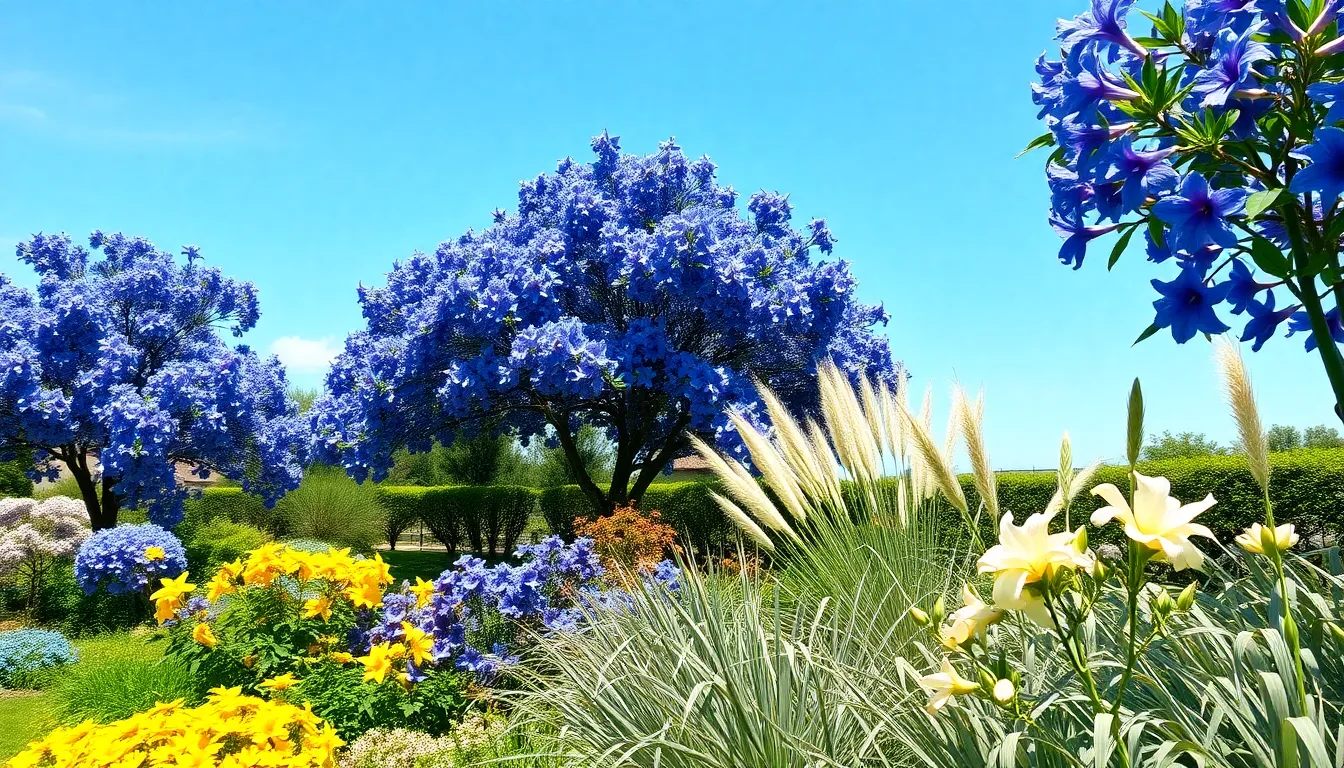
Blue flowering trees transform ordinary landscapes into extraordinary garden showcases that captivate visitors year-round. Strategic placement and thoughtful design approaches maximize their visual impact while creating cohesive outdoor spaces.
Creating Color Schemes and Garden Themes
Monochromatic blue gardens create serene, sophisticated landscapes using various shades of blue flowering trees. Combine deep purple-blue Jacarandas with lighter sky-blue Plumbago trees to establish visual depth and tonal variation. Layer different blue intensities by positioning Blue Chaste trees alongside Blue Hibiscus shrubs for continuous color transitions.
Contrasting color schemes amplify blue blooms through strategic complementary plantings. Pair blue flowering trees with yellow-bloomed companions like Golden Chain trees or bright orange Flame trees to create ever-changing visual tension. Position white flowering dogwoods near Texas Mountain Laurel to enhance the grape-soda purple intensity of early spring displays.
Mediterranean themes work exceptionally well with drought-tolerant blue flowering species. Create coastal garden atmospheres by combining Blue Palo Verde with silvery foliage plants and ornamental grasses. Establish focal points using Empress trees as backdrop canopies while incorporating smaller blue-flowered shrubs as understory elements.
Companion Plants and Complementary Colors
White flowering companions provide stunning contrasts that make blue blooms appear more vibrant and prominent. Plant white gardenias, magnolias, or jasmine near Jacaranda trees to create classic spring combinations. Incorporate white roses or peonies around Blue Chaste trees for elegant cottage garden aesthetics.
Yellow accent plants enhance blue flowering displays through natural color wheel principles. Position golden pothos, yellow daylilies, or marigolds beneath blue flowering canopies for cheerful garden schemes. Add yellow-variegated hostas or golden euonymus shrubs to create layered textures with contrasting foliage.
Silver and gray foliage plants complement blue flowers while extending visual interest beyond blooming seasons. Combine dusty miller, lamb’s ear, or artemisia with Texas Mountain Laurel to highlight silvery leaf textures. Plant lavender, rosemary, or sage near Blue Hibiscus for aromatic Mediterranean garden combinations.
Seasonal Interest and Year-Round Appeal
Spring displays maximize early season impact through strategic blue flowering tree combinations. Plant Texas Mountain Laurel for February grape-scented blooms, followed by Jacaranda’s late spring purple-blue canopies. Establish Wisteria vines on pergolas to create overhead blue flower curtains during peak spring months.
Summer continuity maintains blue flower interest through heat-tolerant species and extended blooming periods. Position Plumbago trees for continuous sky-blue clusters from spring through fall seasons. Incorporate Blue Hibiscus containers that produce daily fresh blooms throughout warmer months.
Fall transitions extend blue flowering seasons while preparing gardens for winter dormancy. Blue Chaste trees provide late summer lavender spikes when most other flowering trees fade. Combine evergreen Texas Mountain Laurel foliage with deciduous blue flowering trees for textural contrasts during autumn months.
Winter structure maintains garden appeal through attractive bark textures and interesting branch patterns. Jacaranda’s fern-like bare branches create delicate winter silhouettes against evergreen backgrounds. Position Empress trees to showcase their distinctive bark patterns and substantial winter presence in dormant landscapes.
Conclusion
Blue flowering trees offer endless possibilities for creating breathtaking landscapes that inspire and delight year-round. Whether you’re drawn to the majestic Jacaranda’s purple-blue canopy or the delicate charm of Plumbago’s sky-blue clusters each variety brings its own unique character to your outdoor space.
We’ve equipped you with the knowledge to select care for and design with these remarkable trees. From understanding soil requirements to creating stunning color combinations the path to your dream blue garden is now clear.
Start small with one statement tree or go bold with multiple varieties – your blue flowering industry awaits. These trees don’t just add color; they create memories and transform ordinary yards into extraordinary sanctuaries that you’ll treasure for years to come.
Frequently Asked Questions
What is the most popular blue flowering tree?
The Jacaranda is the most recognizable blue flowering tree, known for its breathtaking purple-blue trumpet-shaped blooms that create dense clusters covering the entire canopy. It transforms neighborhoods into stunning wonderlands during its late spring to early summer blooming period, making it a premier choice for gardeners seeking dramatic visual impact.
When do blue flowering trees typically bloom?
Blue flowering trees bloom at different times throughout the year. Jacarandas bloom from late spring to early summer, Blue Chaste Trees flower in late summer and early fall, Texas Mountain Laurel blooms from February to April, and Blue Hibiscus provides continuous blooms from spring through fall.
Are blue flowering trees difficult to care for?
Most blue flowering trees are relatively low-maintenance once established. The Blue Chaste Tree is particularly drought-tolerant, Texas Mountain Laurel thrives in various soil conditions, and Plumbago excels in heat tolerance. Key care requirements include proper soil drainage, appropriate watering schedules, and regular pest monitoring.
Can blue flowering trees grow in cold climates?
Some blue flowering trees can tolerate cold climates. Wisteria is particularly cold-hardy and thrives in northern regions, surviving harsh winters while producing spectacular blue flower clusters. However, tropical varieties like Blue Hibiscus require warmer temperatures and may need container growing in colder areas.
What companion plants work well with blue flowering trees?
Blue flowering trees pair beautifully with yellow and white flowering plants for contrasting color schemes. Heat-tolerant companions like succulents work well with Plumbago, while creating monochromatic blue gardens with various blue-flowering plants can provide stunning visual continuity throughout different seasons.
Do blue flowering trees attract wildlife?
Yes, blue flowering trees are excellent for attracting beneficial wildlife. Blue Chaste Trees and Plumbago attract butterflies and pollinators, while Empress Trees draw hummingbirds with their fragrant tubular flowers. These trees enhance garden biodiversity while providing beautiful blooms.
Are there any safety concerns with blue flowering trees?
Texas Mountain Laurel produces fuzzy seed pods containing toxic seeds that can be dangerous for children and pets. The Empress Tree can be invasive in some areas, potentially outcompeting native vegetation. Always check local regulations and choose sterile cultivars when available.
How fast do blue flowering trees grow?
Growth rates vary significantly among species. Empress Trees are extremely fast-growing, potentially reaching 10-15 feet in their first year under optimal conditions. Other varieties like Jacaranda and Texas Mountain Laurel have more moderate growth rates, allowing for better long-term garden planning.
